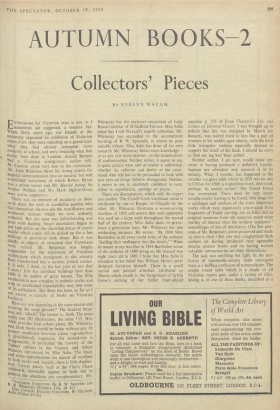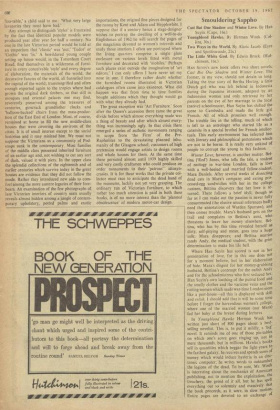AUTUMN BOOKS 2
Collectors' Pieces
BY EVELYN WAUGH ENTHUSIASM for Victorian taste is not, as I sometimes see suggested, a modern fad. When, forty years ago, my friends at the university organised an exhibition of Victorian objets d'art, they were repeating on a grand scale what they had already attempted more modestly at school, and were imitating what had earlier been done in London. Arnold Bennett had a Victorian dining-room earlier still. M. Cocteau came very late to the movement. Mr. John Betjeman threw his strong talents for Popular communication into an esoteric but well established movement of which Robert Byron was a prime mover and Mr. Harold. Acton, his brother William and Mr. Mark Ogilvie-Grant Were active supporters. There was an element of jocularity in those early days, the wish to scandalise parents who had themselves thrown out the wax-flowers and vvoolwork screens which we now ardently collected. But the taste was habit-forming and grew with feeding. Smart decorators began to put high prices on the charming pieces of papier mache which could still be picked up for a few shillings in provincial junk shops. But it was chleflY as objects of ornament that Victoriana were valued. Mr. Betjeman was largely responsible for the enjoyment of Victorian architecture which immigrants to this country have transformed into a serious, critical science. It Is only, I think, ih the last year or two that Country Life has admitted buildings later than 1840 to its studies of great houses. The little revolution is now complete in aesthetic circles and with its established respectability may lose some
its ts enthusiasts. But there has been, so far as I am aware, a scarcity of books on Victorian furniture.
Here are two appearing in the same season and covering the same ground.* The hesitant buyer may ask : which? The answer is: both. The more costly has 282 illustrations, the other 135. Miss Alstn provides four colour plates, Mr. Whineray °fle. Both books would be better without any. In ?resent conditions first-rate colour reproduction prohibitively expensive, the second-rate is disagreeable; in particular the travesty of the Talbert cabinet in the Victoria and Albert Museum introduced by Miss Aslin. The black and white reproductions are almost all excellent in both books and, happily, there is little duplica- l100. Certain pieces, such as the Chevy Chase sideboard, inevitably appear in 'both but in general the selections are complementary. Mr. B. iyICTORIAN FURNITURE. By R. W. Symonds and
in WhineraY. (Country Life, £4 4s.) Aslin
.7Tti CENTURY ENGLISH FURNITURE. By Elizabeth -. (Faber, £3 3s.)
Whineray has the exclusive enjoyment of Lady Rosse's interior of 18 Stafford Terrace. Miss Aslin alone has Lord Wraxall's superb collection. Mr. Whineray has succeeded to the accumulated learning of R. W. Symonds, to whom he pays suitable tribute. Miss Aslin has done all her own research. Mr. Whineray shows more knowledge— or at any rate more interest—in the technicalities of craftsmanship. Neither writer, it seems to me, is quite certain what sort of reader is addressed; whether the collector and dealer or the unini- tiated who still has to be persuaded to look with new eyes on things hitherto disregarded. Neither, it seems to me, is absolutely confident in taste, either in reprobation, apology or praise.
There are discrepancies, which only the expert can resolve. The Castell Coch washhand stand is attributed by one to Burges, to Chapple by the other. Mr. Whineray illustrates a wood-carving machine of 1845 and asserts that such apparatus was used on a large scale throughout the second half of the century. Miss Aslin dates its preva- lence a generation later. Mr. Whineray has one misleading sentence. He writes : 'By 1880 Max Beerbohm in an essay could write of the esthetes "hurling their mahogany into the streets."' What he meant to say was that in 1894 Beerbohm wrote of the zesthetes of 1880 doing so. He himself was eight years old in 1880. I hope that Miss Aslin is mistaken in her belief that William Morris never designed furniture himself. There is a small carved and painted armchair attributed to Morris which stands in the foreground of Sylvia Gosse's etching of her father (reproduced
opposite p. 276 of Evan Charteris's Life and Letters of Edmund Gosse). I was brought up to believe that this was designed by Morris for Rossetti, was indeed fitted to him like a pair of trousers in his middle-aged obesity, with the hard little triangular cushion especially devised to support the small of his back. I should be sorry to find my leg had been pulled.
Neither author, I am sure, would make any claim to having produced a definitive treatise. Sources are abundant and research is in its infancy. What, I wonder, has happened to the circular cut-glass table which in 1939 was on sale in Clifton for £500; a stupendous work, destroyed, perhaps, by enemy action? The Tinted Venus was resurrected. There must be very many notable works waiting to be found. One longs for a catalogue and analysis of the more important works which were ingeniously constructed from fragments of Tudor carving, not as fakes but as original creations from old material, much more worthy of interest than the modern 'sculptors" assemblages of bits of machinery. (The few pew- ends of Mr. Betjeman's poem preserved and made up into a chair.) But one may congratulate both authors on having produced very agreeable interim picture books and on having written valuable commentaries on their illustrations.
The task was anything but light. In the pro- fusion of nineteenth-century trade catalogues there is a baffling confusion of nomenclature. The simple round table which is a staple of all Victorian rooms goes under a variety of titles. Seeing it, in one of these books, described as a 'loo-table,' a child said to me: 'What very large lavatories they must have had.'
Any attempt to distinguish 'styles' is frustrated by the fact that identical popular models were produced year after year for half a century. No one in the late Victorian period would be told at an emporium that 'classic' was 'out,' Tudor' or 'Gothic' was 'in.' A bewildered young couple setting up house would, in the Tottenham Court Road, find themselves in a wilderness of furni- ture in every conceivable 'style' and every degree of elaboration; the materials of the world, the decorative fancies of the world, all funnelled into the capital of the world; transmogrified and often enough exported again to the tropics where had grown the original dark timbers, so that still in mosques and oriental palaces one may find, reverently preserved among the treasures of centuries, gimcrack grandfather clocks and 'balloon-backed' chairs from the mass-produc- tion of the East End of London. Most, of course, remained at home to fill the new middle-class houses that were covering the environs of the cities. It is of small interest except to the social historian and it may mislead him. We must not suppose the Victorians as a community of Pod- snaps sunk in the contemporary. Most families of the middle class possessed inherited furniture of an earlier age and, not wishing to cut any sort of dash, valued it with piety. In the upper class the splendid collections of the eighteenth and of earlier centuries which survive today in the great houses are evidence that they did not follow the mode. Rather they introduced new aids to com- fort among the more austere legacies of their fore- bears. An examination of the few photographs of late Victorian interiors of country seats usually reveals almost bidden among a jungle of contem- porary upholstery, potted palms and exotic
importations, the original fine pieces designed for the rooms by Kent and Adam and Hepplewhite. I suppose that if a century hence a stage-designer wishes to portray the dwelling of a well-to-do Englishman of 1962 he will search the pages of the magazines devoted to women's interests and study those interiors I often see portrayed where the living quarters comprise a single glass enclosure on various levels fitted with metal furniture and decorated with 'mobiles.' Perhaps such places exist outside the imagination of 'art editors.' I can only affirm I have never set my nose in one. I therefore rather doubt whether the furnished rooms illustrated in Victorian catalogues often came into existence. What did happen was that from time to time families bought additions which they thought would go with what they already had.
The great exception was 'Art Furniture.' Soon after the Queen's accession there came the great divide before which almost everything made was a thing of beauty and after which almost every- thing was increasingly ugly. In that crisis there emerged a series of aesthetic movements ranging in scope from 'the Firm' of the Pre- Raphelites to the devastating planned inhu- manity of the Glasgow school; customers of high pretension would engage artists to design rooms and whole houses for them. At the same time there persisted almost until 1939 highly skilled and very costly craftsmen who could produce on order monuments to their 'patrons" idiosyn- crasies. It is for these works that the private col- lector must race to anticipate the dead hand of the museums, luckily not yet very grasping. The ordinary run of Victorian furniture, to which rather too much attention is paid in both these books, is of no more interest than the 'planned obsolescence' of modern motor-car design.















































 Previous page
Previous page